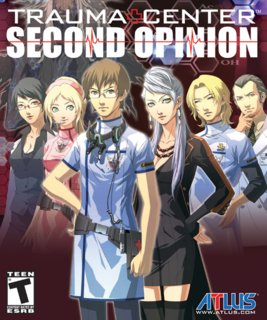Trauma Center is a heart-pounding medical game that will bring out the inner surgeon in almost anyone.
Second Opinion's story outlines the life of a 26 year old rookie doctor named Derek Stiles. To start the game off, players are faced with simple missions, which serve as guides to help you get used to the basic controls. But don't get used to these simple missions; their difficulty will increase rapidly throughout the course of the game. Your basic surgical tools include the scalpel, forceps, suture kit, disinfectant, and many other well-known instruments. As the missions become more intricate, you will begin to incorporate the ultrasound, magnifier, and even the laser to your repertoire of devices. Each mission utilizes the tools in its own unique way, and most of them are a lot of fun to use.
At first glance, this game might seem too easy for some people. After all, they do tell you everything you have to do in each mission. But as you complete the levels, you will have to rely on yourself more than your tutorial doctors for advice and instruction. Basically, the beginning missions familiarize players with the uses of each tool, and after, the game will expect you to figure out some of the uses for yourself. So if you are worried about the difficulty level, just remember that the game gets much harder as you progress from rookie doctor to senior surgeon.
Although Trauma Center's graphics aren't exactly stunning, they do have their own unique style. The cutscenes are basically anime-drawn, and there is little action among the characters. They are almost like comic book style cutscenes, where still frames are racked on to show progression in the story. The in-game graphics seem rather basic at times, but then again, they serve the game well for the most part. Second Opinion wasn't really going for a realistic look, so don't expect to see anything identical to those medical shows on TV.
The sound is ok, but they could have had some voice acting in the cutscenes, instead of just plain text. I feel that it would have instilled a bit more life into the characters. Without good voice acting, it is kind of hard to pay attention to the storyline. Now you might say, "Hey, if you're too lazy to read, then why even play th game?" The truth is, I don't think anyone really wants to read that much text between chapters. As for the in-game sound, its a whole different story. The music is perfect for the gameplay, and players will often hear some very suspenseful music, as well as the heart-beat sound effect when things are really getting bad. The other doctors do occasionally talk, but they usually just scream your name when you do something wrong, or give you a helpful hint if your in a jam. So although the cutscene sound is hardly existant, the in-game music is actually quite good.
As for the gameplay, you basically do most of the things you'd expect to do as a surgeon, as well as some cool, unorthodox missions. The first mission makes you feel like just a regular surgeon, but then Dr. Stiles will begin having headaches and strange visions; that's where the game begins to get interesting. Dr. Stiles eventually discovers that he is not like the other doctor; he has supernatural powers! He can use these powers to help him in even the toughest situations. To use this power, you must hold Z and B, and then draw a star on the screen. It takes some getting used to, but once you get the hang of it it can really come in handy. Its basic function is to slow down time, allowing you to do some quick fixes to get your patient stable again. But even with this awesome ability, the missions are still very challenging.
The Wii-mote works surprisingly well with almost every single function that players must carry out. Most of the tools require drawing lines on the screen with the Wii-mote, which allows this game to maintain its original feel from the DS. Every single tool seems to work in a logical way, and even if you don't know exactly what you are doing, you can still figure it out because of this logical control scheme. The only tools that I had trouble with were the heart paddles, but even they were easy once I learned what to do with them. Throughout the game, you will scalpel, laser, and suture you way through some very exciting missions, some of which even have "bosses" per say.
Trauma Center: Second Opinion is a great addition to the Nintendo Wii. I think that we can most definitely recognize it as one of the better launch titles we have seen over the years. I wouldn't recommend this game for younger children though, because they might have a little trouble following directions and keeping up with the fast-paced missions. If you enjoyed the original Trauma Center on the Nintendo DS, you will most likely find some fun and replay value in Second Opinion.

